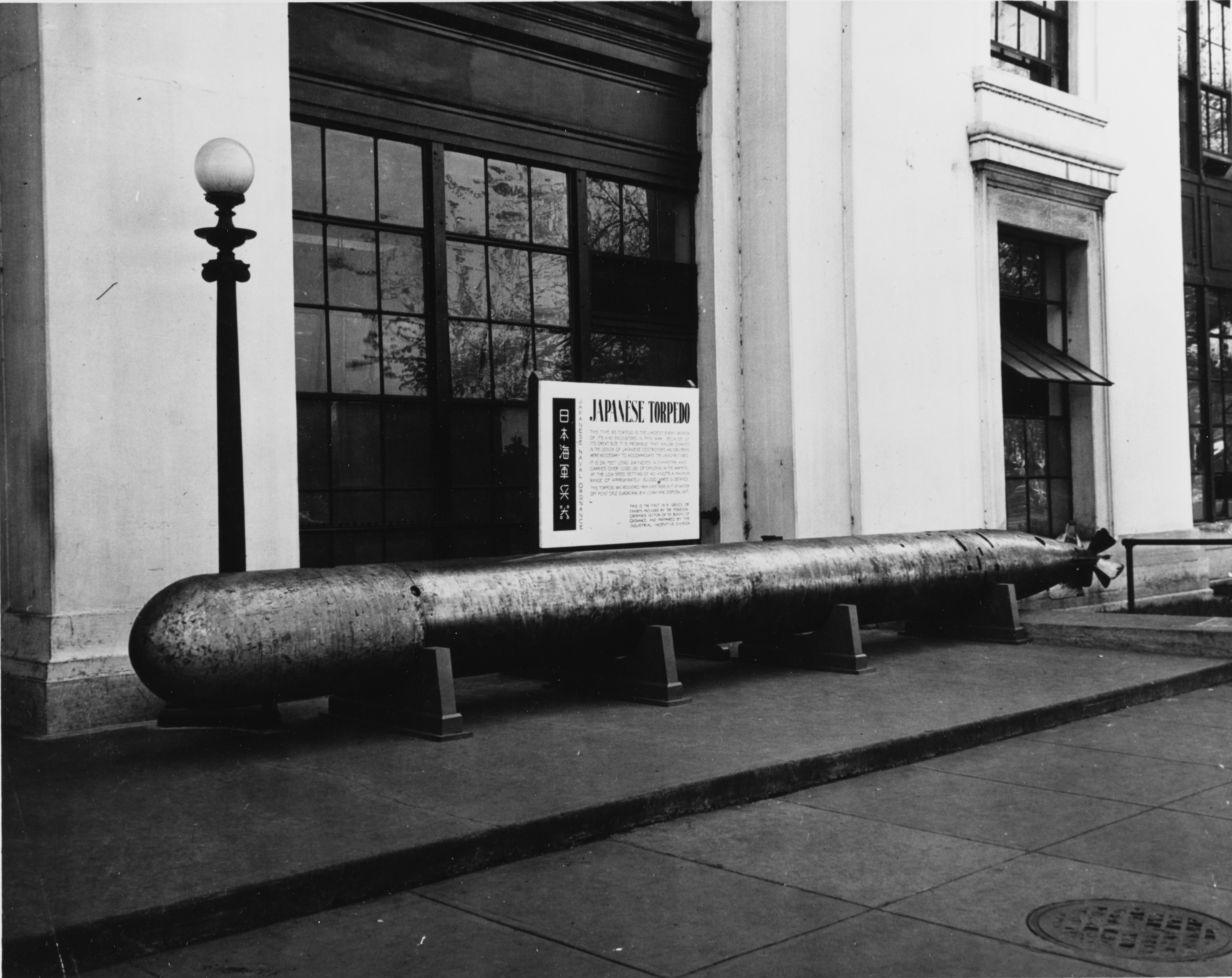
The Japanese Navy invested heavily in developing a large, heavy, and long-range torpedo, the Type 93. Torpedoes were one of the few naval weapons enabling small warships, such as destroyers, to damage battleships. IJN torpedo research and development focused on using highly compressed
oxygen instead of
compressed air as the
fuel oxidizer in the torpedo's propulsion system. These torpedoes used an otherwise normal
wet-heater engine burning a fuel such as
methanol or
ethanol. Since air is only 21% oxygen (and 78% nitrogen), pure oxygen provides five times as much oxidizer in the same tank volume, thereby increasing torpedo range and the absence of the
inert nitrogen resulted in the emission of significantly less exhaust gas, comprising only
carbon dioxide, which is significantly soluble in water, and
water vapor, thus greatly reducing tell-tale bubble trails.
Compressed oxygen is dangerous to handle and required lengthy research and development, not to mention additional training for the warship's torpedomen, for safe operational use. Eventually, IJN weapons development
engineers found that by starting the torpedo's engine with compressed air, and then gradually switching to pure oxygen, they were able to overcome the problem of explosions which had hampered it before. To conceal the use of pure oxygen from the ship's crew and any potential enemy, the oxygen tank was named the
secondary air tank. The pure oxygen torpedo was first deployed by IJN in 1935.
The Type 93 had a maximum range of 40 km (21.6 nmi; 24.9 mi) at 38 knots (70 km/h; 44 mph) with a 490 kg (1,080 lb)
high explosive warhead. Its long range, high speed, and heavy warheads provided a very formidable punch in surface battles. In contrast, the U.S. Navy's standard surface-launched torpedo of World War II, the 21 in (53 cm)
Mark 15, had a maximum range of 15,000 yd (14 km; 7.4 nmi) at 26.5 knots (49.1 km/h; 30.5 mph), or 6,000 yd (5.5 km; 3.0 nmi) at 45 knots (83 km/h; 52 mph), with a significantly smaller 375 kg (827 lb) warhead; torpedoes of other Allied nations did not have longer range. The Type 93 was launched from 61 cm (24 in) torpedo tubes mounted on the decks of IJN destroyers and
cruisers; some Japanese destroyers, unlike ships of other navies, mounted their banks of torpedo tubes in
turrets offering protection against splinters, and had tube loaders. IJN armed nearly all of its cruisers with Type 93 torpedoes.
In the early surface battles of 1942–43, Japanese destroyers and cruisers were able to launch their torpedoes from about 20 km (11 nmi; 12 mi) at the unsuspecting
Allied warships attempting to close to gun range.
Allied warships expected that, if torpedoes were used, they would be fired from not more than 10 km (5.4 nmi; 6.2 mi), their own typical torpedo range. The many torpedo hits suffered by Allied warships in such engagements led their officers to believe torpedoes had been fired by undetected Japanese submarines operating in concert with the surface warships. On rare occasions stray very long-range Type 93s struck ships much further range than their intended targets, leading the Allies on occasion to suspect their ships had been
mined. The capabilities of the Type 93 went mostly unrecognized by the Allies until examples were captured intact in 1943.
A 17.7 in (450 mm) version, the
Type 97 was later developed for
midget submarines, but was not a success, and was replaced operationally by the
Type 91. A 21 in (53 cm) version for use by a few IJN submarines was designated the
Type 95, and it was ultimately successful.
A disadvantage of the Type 93 was that it was far more likely to detonate due to shock than a compressed-air torpedo. The explosion from one Type 93, with its heavy warhead, was usually enough to sink the destroyer, or heavily damage the cruiser, carrying it. As American
air strikes against IJN ships became more common, the captains of destroyers and cruisers under air attack had to decide whether to jettison torpedoes to prevent them from being detonated during the attack.
In one instance heavy cruiser
Chikuma was fortunate to have jettisoned her Type 93s just before being hit by bombs from several USN dive bombers at the
Battle of Santa Cruz Islands. During the
Battle off Samar (in the eastern
Philippines) a five-inch (127 mm) shell from
escort carrier USS White Plains[5] struck heavy cruiser
Chokai. While in most circumstances a shell of this size would not seriously damage a heavy cruiser, this shell detonated the cruiser's torpedoes, disabling her rudder and engines; she was
scuttled the next day.
http://en.wikipedia.org/wiki/Type_93_torpedo